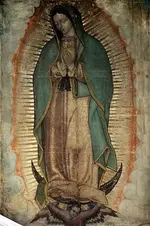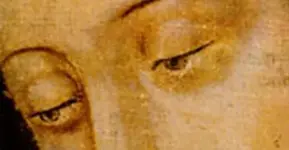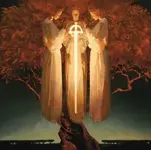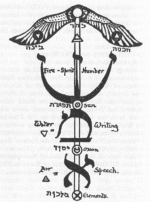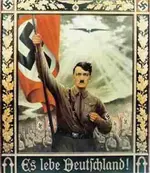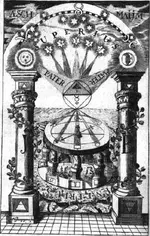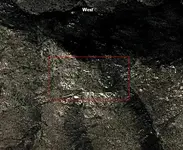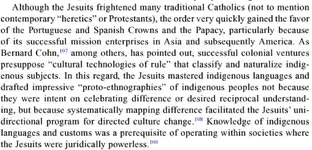In the words of one member of Cortés's band of conquistadors, the Spanish came to the New World "to serve God, and to get rich as all men want to do." Whether or not Bernal Diaz del Castillo got rich is one thing; serving God was quite another. Spain after 1492 was a Catholic country.
Religion in Spanish Colonization
Spain saw itself as the bulwark of Catholicism and doctrinal purity. Spain carried Catholicism to the New World and to the Philippines, but the Spanish kings insisted on independence from papal "interference" - bishops in the Spanish domains were forbidden to report to the Pope except through the Spanish crown. In the 18th century Spanish rulers drew further from the papacy, banishing the Jesuits from their empire in 1767.
Religion in Spain - Wikipedia, the free encyclopedia
The creation of a viceroyalty in the Americas was a result of the Spanish conquest of the Aztec Empire (1519 to 1521). The lands and societies brought under Spanish control were of unprecedented complexity and wealth, which presented both an incredible opportunity and a threat to the Crown of Castile. The societies could provide the conquistadors, especially Hernán Cortés, a base from which to become autonomous, or even independent, of the Crown. As a result the Holy Roman Emperor and King of Spain, Charles V created the Council of the Indies in 1524.
A few years later the first mainland Audiencia was created in 1527 to take over the administration of New Spain from Hernán Cortés. An earlier Audiencia had been established in Santo Domingo in 1526 to deal with the Caribbean settlements. The Audiencia, housed in the Casa Reales in Santo Domingo, was charged with encouraging further exploration and settlements under its own authority. Management by the Audiencia, which was expected to make executive decisions as a body, proved unwieldy. Therefore in 1535, King Charles V named Antonio de Mendoza as the first Viceroy of New Spain.
Sephardic Jews of America's Southwest have just begun to surface after 500 years of obscurity. This Diaspora, during which these particular Jews were totally stripped of their identity, has been longer than the 240 years of exile in Egypt or the 70 years in Babylon. These are remnants of the Spanish and the Mexican Inquisitions of which so many people are unaware.
Twenty-four years after Columbus' initial "discovery," the Franciscan missionaries, who were vested with Spanish Inquisition powers, reported the increasing numbers and the increasing influence in Mexico by Sephardic Jews who were called la gente prohibida (people prohibited from entering the New World). Questions such as who led them here? How did they ever get this far west into the Americas and how they wound up as far north as Texas and New Mexico by the
14th Century? More importantly, why and how did the "Holy Inquisition" in Spain ever wind up with a High Tribunal in Mexico City? And, is there a possibility that the early Catholic Missions were somehow instructed to keep as eye on these Western Jews of Spain and the Iberian Peninsula?
Hernan Cortez led the procession of Spanish explorers and Conquistadors into the New World. It is documented that some of these explorers, soldiers and early settlers were, in fact, Sephardic Jews. Some of these had faithfully served the Spanish Crown -- men such as Captain Alberto del Canto, Diego de Montemayor, Gaspar Castano de Sosa and many others. Among these early explorer-Conquistadors of the 16th Century were two who made very significant advances into Northern Mexico and the Southwest of the United States. They were Juan de Onate and Don Luis de Carvajal y de la Cueva.
On May 31, 1579, the Spanish Crown issued a colonization charter to Don Luis de Carvajal y de la Cueva. He was appointed the First Governor-Captain General over an enormous piece of land known as El Nuevo Reyno de Leon (New Kingdom of Leon). Because of the unusual set of circumstances that arose in the process of these pioneering efforts, Don Luis's Reyno eventually encompassed a large section of the Vice Regency of New Spain and the existing kingdoms of Nueva Galicia and Nueva Vizcaya. For all intents and purposes this section of land covered most of Northern Mexico and much of what is today New Mexico and south-central Texas, including the Alamo City of San Antonio.
The irony lies in the identity of the passengers on Don Luis' ship, La Santa Catalina that landed at Tampico, Mexico in 1580. The fact is that all the passengers, who had been recruited from across Spain and the Iberian Peninsula, were members of his and his wife's family, and they were all Sephardic Jews. In fact, Don Luis' successor was his own nephew, Luis de Carvajal el Mozo ("the younger"). He too was a Sephardic Jew who, rather than deny his faith, was burned at the stake, together with his mother and three sisters, in Mexico City in 1589. Don Luis died in prison for the same reason around February 13, 1591.
The Sephardic Awakening in America
saturday, january 05, 2013
KING JUAN CARLOS OF SPAIN-TITLE KING OF JERUSALEM
EU DICTATOR (WORLD LEADER)
The King's title in full: His Majesty Juan Carlos the First, By the Grace of God,the King of Spain, King of Castile, of León, of Aragon, of the Two Sicilies, of Jerusalem, of Navarre, of Granada, of Seville, of Toledo, of Valencia, of Galicia, of Sardinia, of Córdoba, of Corsica, of Murcia, of Jaén, of the Algarves, of Algeciras, of Gibraltar, of the Canary Islands, of the East and West Indies, of the Islands and Mainland of the Ocean Sea; Archduke of Austria; Duke of Burgundy, of Brabant, of Milan, of Athens and Neopatria; Count of Habsburg, of Flanders, of Tyrol, of Roussillon, and of Barcelona; Lord of Biscay and of Molina de Aragón; Captain General and Supreme Commander of the Royal Armed Forces; Sovereign Grand Master of the Order of the Golden Fleece and of the orders awarded by the Spanish state.
http://israel7777777.blogspot.com/2013/01/king-juan-carlos-of-spain-title-king-of.html
Sephardic Jews eager to apply for Spanish citizenship Feb 17, 2014
The Spanish government recently announced it would grant citizenship to the descendants of Sephardic Jews expelled from Spain five centuries ago. On Feb. 7, Spanish Minister of Justice Alberto Ruiz-Gallardon announced a bill that would allow Sephardic Jews dual citizenships. Spanish Jews were expelled from Spain in 1492 by an edict of the Catholic monarchs, Isabella and Ferdinand, during the height of the Spanish Inquisition, an effort intended to maintain Catholic orthodoxy in the kingdom.
The bill fast-tracks the process and provides six different ways to prove Sephardic origins, such as “having a Sephardic last name,” “evidence of belonging to the Sephardic community,” or speaking Ladino — a form of medieval Spanish spoken by Sephardic Jews.
“Why is Spain, one of the most restrictive countries in terms of immigration and asylum, now offering citizenship to a potential large number of people?” asked de la Obra.
http://www.religionnews.com/2014/02/17/sephardic-jews-eager-apply-spanish-citizenship/
http://www.pineradelolmo.com/en/spanish-citizenship-sephardic-jews/
The basic accusation of the Inquisition was that Jews who converted to Christianity were still secretly Jewish. In 14th century Barcelona, for example, the whole Jewish community was murdered by a rioting mob. First given shelter by some Christians, these Jews were pressured to convert. “Those of them who refused to accept baptism were immediately slain, and their corpses, stretched in the streets and the squares, offered a horrendous spectacle.”
The Origins of the Inquisition by Professor B. Netanyahu
Many of those who converted did so only outwardly, continuing to practice Judaism in secret. In due time, the Christians caught on to these phony conversions and decided to root out the heretics.
THE SPANISH INQUISITION began officially by papal bull issued by Pope Sixtus IV on November 1, 1478. The very first Inquisition actually took place in 1233 under orders from Pope Gregory IX to combat a group of French-Christian heretics called “Albigenses.”
http://www.simpletoremember.com/articles/a/the_inquisition/


 I'm sorry, I couldn't help myself. But seriously, what else erupts? I'd go with volcano over ironwood personally. But, as a couple of you know, I have the most tender of feet in regards to all of this, so the most I can really add to this conversation is fresh eyes, a working brain (sometimes), and a light heart.
I'm sorry, I couldn't help myself. But seriously, what else erupts? I'd go with volcano over ironwood personally. But, as a couple of you know, I have the most tender of feet in regards to all of this, so the most I can really add to this conversation is fresh eyes, a working brain (sometimes), and a light heart.